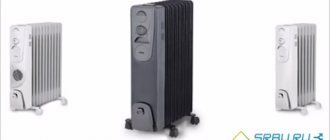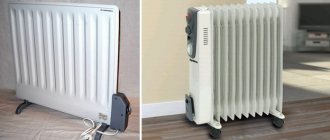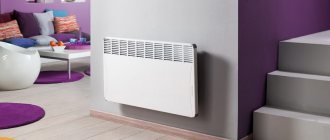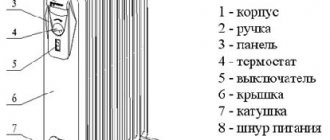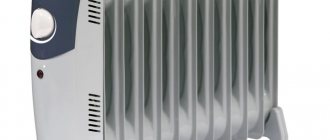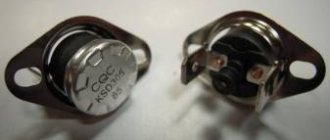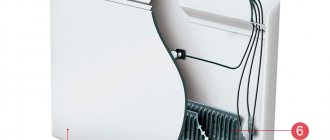How to prevent an explosion
To prevent the heater from exploding, you must strictly adhere to the basic rules of its operation.
Your own safety and the safety of your property depends on this. These rules are quite simple and will not require much effort from you to follow. So, the rules for the safe operation of such equipment are as follows: The oil heater cannot be used in a horizontal position, otherwise it will overheat, which can lead to an explosion.
- The device must not be used in a horizontal position. In this position, the equipment will instantly overheat. For such cases, a special thermostat is installed in the devices, which ensures that they turn off when overheated, but you should not tempt fate if it is possible to avoid dangerous situations.
- Do not leave the device unattended. This is especially true if you have small children or pets living with you. They may unintentionally change the unit's settings or overturn it. In addition, there is a high chance that children may get burned. The oil heater should only be operated under your supervision.
- After the summer season, when the device has not been working for a long time, it is imperative to check the serviceability of its thermal relay before starting operation. During such a test, the device should turn off when operating temperature is reached. If this does not happen, then you cannot use the heater. It must be sent for repair or thrown away and purchased a new one. The serviceability of the thermostat is very important for the safe use of an oil heater, since most of the unpleasant consequences from their incorrect operation are associated with overheating of the device.
- A device that has developed a leak cannot be repaired. Theoretically, it is possible to seal it somehow, but in this case there will be less liquid inside the container with oil, since a significant part of the oil can leak out even through minor damage to the housing. It is unknown how equipment will operate with missing mineral oil. The heater may behave unpredictably during operation.
It should be remembered that no electrical device can be absolutely safe. However, there are safer options than oil heaters. The modern market for such equipment offers many alternatives, so if you are concerned about your safety, it is advisable to opt for a more modern and easy-to-use model.
In any case, if you are using an oil heater, you can avoid its explosion by following a few simple rules. Be careful and vigilant so that the heater in your home does not explode and cause damage to your property, health or even life.
Problem prevention
Despite the fact that changing the oil in most cases is quite simple, it is still better not to let the situation get to this point. If you follow important operating rules, the oil heater will serve faithfully without any incidents.
The main recommendation is the choice of installation location. More precisely, it is extremely undesirable to place such a heating device in a children's room. There are two reasons for this:
- During operation, the radiator body becomes very hot. This is the main disadvantage of this type of heating equipment. Even if you accidentally touch the surface of the case, you can get seriously burned. And everyone knows that children are quite active and do not always look in front of them. In general, for safety reasons, it is better not to combine an oil radiator with a children's room. However, if you want to use this particular type of device, then you can purchase a model equipped with a protective casing. It will protect children from burns because it completely covers the body of the product;
- The body is made of fairly thin material. This leads to the fact that it is not particularly resistant to mechanical damage. Children's curiosity and love of active games can make the need for an oil change more than a regular occurrence. In addition, if the housing is damaged, as mentioned above, the oil quickly flows out. If at this moment it is as warm as possible, you yourself understand what this means when contacting children. It's better not to take risks.
Another recommendation is to purchase a device that includes overheating and tip-over sensors. They have already been discussed above. Such regulators, which automatically turn off the device in the event of force majeure, can repeatedly save equipment from serious breakdowns.
Overall, an oil cooler is an excellent heating device. If you do not take into account the repair procedure, which is not necessary if used correctly, then this device does not cause any trouble.
It has an excellent appearance, and the equipment is presented in stores in both floor-mounted and wall-mounted versions, which allows you to choose the optimal model specifically for your interior. The efficiency of the device is very high, and all the necessary actions of the owners consist of connecting the equipment to the network.
In addition, some models have advanced functionality. For example, an on/off timer will make the operating process as comfortable as possible. Energy savings will be a pleasant bonus, since the heating device will not work in vain.
In general, this is quite a worthy purchase, and for the sake of its use it is quite possible and necessary to tinker with repairs. An oil heater will effortlessly bring warmth and comfort to your home. We are sure that after today’s article you will not have any questions about the selection of oil and the possibility of changing it. Good luck!
In accordance with applicable law, the Administration disclaims any representations and warranties that may otherwise be implied and disclaims liability in relation to the Site, the Content and its use. More details: https://seberemont.ru/info/otkaz.html
Was the article helpful?
Tell your friends
Advantages and disadvantages of oil radiators
The disadvantages of such radiators are the strong heating of the surface (you can get burned or damage fusible items located nearby). Another important drawback is that all radiators significantly dry the air and also increase the dustiness of the room (heat raises dust particles from the surfaces).
Design and principle of operation of oil radiators
The working element of radiators is made of ferrous metal up to 1 mm thick. Metal parts are produced on a laser machine, since only their exact dimensions make it possible to achieve tightness during assembly. Small parts are formed by stamping. The elements of the device are connected by spot welding and pressing. The radiator is assembled from ready-made sections (a nipple connection is used). A heating element is placed inside the device, panels are mounted outside, a thermostat, regulator, and overheating protection are installed. Mineral oil is poured into the device. When the device is turned on, heating occurs in stages - first the heating element (heating element) heats up, then the heat spreads to the oil and only then does the housing warm up.
Additional elements of oil radiators
To reduce the risk of burns, some radiator models are equipped with a protective casing. Such models are especially often used in children's rooms. The next additional element allows you to maintain optimal humidity in the room - manufacturers equip radiators with a metal container for water (when heated by the body, it evaporates). Another useful element is the fan. Some devices are equipped with it to increase efficiency (the fan distributes warm air throughout the room).
Another useful detail is the timer. With its help, you can control the switching on of the device (the radiator turns on and starts heating the room at the set time).
Oil radiator power
Its heat transfer depends on the power level of the device. On average, 10 sq.m. for heating. 1 kW is consumed. On sale you can find devices with a power of 1 to 3 kW. Almost all models allow you to adjust the heating level (2-3 positions), which saves energy.
Width and number of oil cooler sections
The efficiency of heating depends on the number of sections - the more there are, the more heat the device produces. Another important factor is the width of the sections. Here you need to find a middle ground - narrow sections reduce energy consumption, maintain the set temperature longer, but warm up the air worse (due to the small recoil area). Wide sections heat the room better, but they lose the accumulated temperature faster, which means the device turns on more often and wastes more energy.
Oil radiator weight
When purchasing a radiator, you should pay attention to its weight - it must correspond to the dimensions. If a sufficiently large device is light in weight, this indicates the use of thin metal or a small amount of oil, which inevitably affects the quality of heating and the reliability of the device
Oil radiator color
It is believed that radiators painted in a darker color heat the room better
Based on this, it is better to pay attention to black radiators. However, experts say that if this factor matters, it is absolutely insignificant.
Rules for operating oil radiators
It is not recommended to install high-power devices in small rooms - they disturb the microclimate. Do not install devices close to walls (the relay will constantly turn off the device, which will affect its efficiency). The optimal distance to the wall is at least half a meter.
It is not recommended to dry things on the radiator by closing the sections. It is better to hang them on a hanger and place a heater nearby.
If the radiator has turned over, you need to immediately turn it off, put it in its original position and wait a while (you can’t turn it on right away). In a device that has fallen on its side, oil flows from the heating element, which heats up to very high temperatures (about 800 degrees). This causes the radiator to rupture with oil and can cause a fire.
You cannot connect a device with a faulty overheating sensor to the network (if it does not turn off, the device will become very hot, which can lead to a fire).
You cannot turn on a device that has been in a cold room - you need to wait until it warms up to room temperature naturally. Otherwise, the device body will be damaged and oil will leak out.
Under no circumstances should you pull the device by the cord when moving it from place to place - breaking the integrity of the wires will cause a short circuit.
By choosing the right radiator and following simple rules for its operation, you can count on long-term operation of the heater.
Design and operating principle
The design of the oil cooler is quite simple. It consists of a housing filled with oil and one or more heating elements. The heater is controlled by the existing regulator. It allows you not only to turn the device on or off, but also to regulate the intensity of work. Modern models of oil heaters can be additionally equipped with:
- fan;
- timer;
- remote control.
Attention: The oil contained in the heater body makes it possible to achieve high-quality heating of the room, has a positive effect on the safety of the device and makes it possible to save money. In terms of heat conductivity, oil is significantly superior to air.
Read more about inverter heaters here.
The operating principle of an oil heater is as follows: heating elements immersed in oil heat up, resulting in an increase in the temperature of the filler, which transfers heat through the body to the room. Due to the fact that the cooling of heating elements in oil occurs quite quickly, oil heaters have high efficiency. Many modern models of oil heaters are equipped with built-in fans. With their help, a faster heating rate of the room is ensured.
Oil radiators are quite reliable, but they can still break down. There are different types of breakdowns, but one of the most common is an oil leak. In the event of such a malfunction, it is necessary not only to eliminate the leak, but also to add oil to the heater.
According to user reviews and its composition, transformer oil is best suited for these purposes. Moreover, it is quite affordable and finding it will not be much of a problem.
Oil-filled heater operation
The operating principle of the oil cooler is as follows. When the device is connected to the electrical network, the device goes into standby mode. To turn it on, you need to select an operating mode; it is selected using an adjustable thermostat.
Other models on the case have two power adjustment keys; when one of them is turned on, the following circuit is connected: power is supplied to the fuse, then the current passes through the heater spiral, indicator light and mode switch contacts. After this, it passes through the closed tip-over protection contacts; if the heater is tilted strongly, these contacts are open and the device will not turn on. Then the current passes through the contacts of the emergency and adjustable thermostat and goes into the network. If you need to increase the heating speed, turn on the second heater coil using another key, which is connected in parallel to the first.
How do thermostats work? As the heating element heats up, the oil around it also begins to heat up and rise, and cold oil comes in its place. This is how the entire volume of coolant is mixed and heated.
Action of heating element
Heat is transferred to the walls of the radiator and then to the surrounding air. The thermostats located in the lid begin to heat up. When the set temperature is reached, the thermostat operates and disconnects the circuit. After the thermocouple has cooled, the contacts close and the heating process continues. For clarity, you can watch this video:
The emergency thermostat protects against overheating; it is adjusted at the factory to the maximum temperature. If for any reason the service thermostat does not operate, the circuit will open the emergency device, preventing damage that could be caused to the heater.
It can be returned to its working position by pressing the corresponding button. This design allows the owner to find out if a malfunction has occurred; it must be eliminated before starting to use the device again. If there is no such button, the heater must have an emergency valve. De-energization will also occur if the electric heater is tipped over due to the activation of the tip-over protection.
Why can't you leave the heater on overnight?
You can only leave heaters that have an automatic shut-off function. In this case, when the temperature rises above the set level, the device turns itself off. This protects from fire and from overheating of the air, which leads to dehydration of the human body in a hot room.
Interesting materials:
What is the period of the sine function? What is sin 90 A equal to? What is the inscribed angle? What is the equilibrium constant of a chemical reaction? What is the second escape velocity at the Earth's surface? What does T equal in physics? What is the tangent of 90 degrees? What are the abscissas of points lying on the coordinate axis? What are the base angles in an isosceles right triangle? What are the angles in an isosceles trapezoid?
Basic faults
There are not many reasons why an oil heater does not work. Conventionally, they can be divided into two parts – electrical and mechanical. Failures in the operation of electrical equipment most often occur in heating elements and control communications - thermal relay, switch, thermal fuses. There may be a problem with the wiring, but this is extremely rare.
Mechanical damage includes various holes in the housing, as well as the formation of shells on it through which oil leaks. As a rule, these are the fruits of corrosion activity. Determining the type of malfunction is not very difficult. Mechanical failures are always associated with oil stains under the heater. All other faults are related to the electrical part.
Removing a faulty heating element
When dismantling the heating element, the heater should be located on the rear edge. It turns out that the heating element itself should be on top. This is necessary so that during the replacement process, oil, which is a coolant, does not leak out of the radiator.
If you don’t have a suitable size wrench, you can use a gas one. With its help, the old heating element is unscrewed, after which it can be pulled out.
Using a gas wrench, you can freely unscrew the faulty heating element from its seat
The problem in the example under consideration was a breakdown of the heating element on the housing, which could even lead to ignition of the oil and explosion of the radiator (if the automatic protection system does not work). And what a heating element with a similar problem looks like can be seen with the naked eye.
Appearance of a heating element punched into the body - all the tubes are swollen and deformed
Selecting an oil cooler according to parameters
It is impossible to clearly say which heater from which company is better. There is a huge selection of models on the market. The best manufacturers will always offer reliable housings and trouble-free safety and adjustment systems
But it is important to know how to choose an oil radiator based on the main parameters
Power
The main criterion when choosing an oil heater is power. The recommended rate is calculated based on the area of the heated room at the rate of 100 watts per 1 sq. m. But this is the maximum selection rate.
In practice, to comfortably heat a room of 20 square meters, 1500 watts of heater is enough. Moreover, the greater the number of sections (the area of contact with air), the faster the room will warm up and the more stable and economical the operation of the device will be.
Radiator type
The radiator is chosen according to personal preference. The flat heater fits conveniently against the wall, can be located behind the back of the sofa or even mounted on the wall. A sectional device with simple soldering is more compact and can be easily placed next to your favorite place in the room. A device with safe ribs or a tubular double body is the optimal solution for a nursery or apartment where little fidgets are constantly running around.
Number of heating elements
A device with one heater is functional and, with sufficient power, can act as the main heating device. But the amount of heat can be excessive even when operating at half the energy output. Therefore, a model with two heating elements is more practical; it can be used as the main source of heat or an additional means of heating.
Adjustments
If we consider the rating of oil heaters, there are no models that do not offer at least two stages of heat transfer. But it is best to buy a product that has smooth adjustment. This is a heater with two heating elements of different power.
Such a device can operate in three modes - weak heating element, powerful heating element, two at once. These are the basic stages of heat transfer. By supplementing this functionality with a main temperature sensor that controls oil parameters, you can get smooth adjustments that allow you to adjust the microclimate in the room at the owner’s request.
Security systems and components
In conclusion, let’s look at another important aspect: how to choose the right oil heater. It has several components whose characteristics directly affect service life, safety and likelihood of repair.
- Boil protection. If for some reason the oil temperature exceeds a critical level, the radiator may simply burst. To prevent this from happening, high-quality oil heaters are equipped with a mechanical two-component sensor. It operates independently of other instrument systems. If the temperature or pressure in the radiator is exceeded, the electrical circuit is broken. In this case, the fuse sensor fails, but replacing it is inexpensive compared to repairing the radiator or eliminating the consequences of the release of boiling oil.
- Protection from dangerous power grid parameters. Short circuits, out-of-phase, sudden voltage surges can cause a variety of troubles. Therefore, it is imperative that the oil heater be equipped with an electrically replaceable fuse.
- Design of thermostats. Reliable heaters are equipped with trouble-free, maintenance-free temperature sensors built on a bimetallic plate. Other schemes are unreliable and require maintenance. The bimetallic strip works for decades and is easily and quickly replaced.
Taking into account all the listed criteria and choosing the right oil heater is not difficult at all. Just ask the seller a few questions. If you remember to do this, the purchased device will serve for a long time and will not cause trouble.
Aspects of choosing a heating device
How to choose the right oil heaters for your cottage and home? In this case, pay attention to the power of the device, its size, the presence of additional characteristics (climate control system, fan, humidifier, clothes dryer).
The heater heats the room due to air convection.
Power or performance. According to building codes, heating a room with an area of 10 square meters requires 1 kW of thermal energy. At the same time, the house or apartment is insulated, and the temperature outside is as low as possible. Therefore, for a room of 15 sq.m. you need a radiator with a power of 1.5 kW. However, you need to remember that the equipment cannot operate for a long time at the maximum possible power, since the electrical part may fail. Experts recommend choosing a heater “with a reserve” in terms of performance, that is, for a room with an area of 15 sq. m. - 17 sq. m., it is better to buy a device with a capacity of 2 kW.
Section thickness. In this case we are talking about the efficiency of the equipment. Radiators with thin sections heat up quickly and are characterized by economical energy consumption. But here their heat capacity decreases, that is, the device will not be able to warm up a large room. A heater with thick sections, on the contrary, will have high performance, but at the same time it consumes a large amount of electricity. Which oil heater is best for an apartment? This is a device with an average thickness of sections, where a reasonable balance is maintained between their power, energy consumption and performance.
Device weight. Depending on the number of sections, the weight of the heating element can vary between 18-25 kg. If the purchase weight is less than the specified values, this should alert you. In this case, the buyer has a defective product. And here you don’t need to think about what kind of oil is poured into the heater and how to do it, but simply refuse to buy, even if the price is very attractive.
Any electrical product must be purchased from a specialized store and checked for a quality certificate. Otherwise, you may buy a defective product.
Additional functions. This is a control panel, a fan, a humidifier, and a clothes dryer. They will not only simplify the operation of the equipment, but also increase its performance and functionality.
Are you choosing oil heaters for your home? Consumer reviews will help create a correct picture of the product on the modern heating appliance market, and therefore you need to familiarize yourself not only with the range of products in stores and listen to expert advice there, but also read people’s opinions on thematic forums.
Where can you buy an electric double-circuit boiler for heating your home and is it really possible?
You can learn everything about an energy-saving electric heating boiler from this article.
Rating of the best oil heaters
The best way to show how selection criteria work in practice is to meet some excellent representatives of the oil heater market.
- Timberk TOR 21.1507 BC/BCL An excellent representative of the universal heater segment. It has seven sections, which is enough for intense heat transfer. A power of 1500 watts is enough for a room of 20 square meters, while the device can be used in operating mode even in an apartment with not the most modern wiring. The undoubted advantages include:
- the presence of two heating elements of different power (one of the regulators switches 3 modes, the second controls the oil temperature) for smooth adjustment;
- reliable mechanical temperature sensors;
- automatic protection against freezing and boiling of oil.
The device is made in a convenient case on wheels, there is a handle for movement and a compartment for the cord. UNIT UOR-723 Equipped with a fan, this oil radiator is designed to quickly warm up the room. Having a power of 1500 watts, it is designed for a room of 20 square meters. The heater is reliable thanks to the use of mechanical thermostats. At the same time, the device is lightweight, the amount of oil is less than models similar in energy consumption. The intensity of heat transfer is increased by supercharging, so the radiator does not require significant reactivity (long-term temperature maintenance).
The heater has a pair of heating elements of the same power, so the output stages are with the same step. Paired with oil temperature control, you can smoothly set the speed of heating the room. For the convenience of the owner, the heater is equipped with a handle, and the wheelbase is wide enough for the device to remain stable and not cause trouble.
UNIT UOR-997 A model that can be called a representative of the classic oil heaters. Simple adjustment, three stages of power output and a temperature controller allow you to heat a room with any characteristics. Having a power of 1500 watts and designed for 20 square meters, the device is able to create comfort over a larger area. It has 9 sections and a good fireplace effect (heat transfer by radiation). By placing such a heater next to you, you can enjoy comfort even in a large unheated hangar. Timberk TOR 21.1005 SLX This inexpensive oil cooler has a number of shortcomings that do not allow it to be given the highest quality rating. However, the model is very functional and is able to show excellent results in a room without significant parasitic heat loss. The main thing that users and service engineers note as negative features is electronic oil temperature control and only two wheels. The reliability of the circuit is lower than that of mechanical regulators. And moving the device is somewhat unusual: you need to lift one side by the handle.
The model has an energy consumption of 1000 Watts and in stable operation mode can be effectively used in a room of up to 15 square meters. Both the low power and the number of sections prevent the device from exceeding the recommended area. There are only 5 of them, which does not allow energy to be transferred to the air with sufficient intensity. Timberk TOR 21.2512 BC/BCL A peculiar ideal completes the rating. The heater, which has as many as 12 sections and 2500 watts of power, can easily work as the main source of heat in a room of up to 30 square meters. In this case the device:
- equipped with two heating elements with three degrees of energy output adjustment;
- equipped with a reliable mechanical oil temperature sensor;
- protected from freezing and overheating;
- Made on a comfortable wheel base, with a handle and a cord compartment.
The heater is functional and can work even in a small room. When set to low output, it will both generate enough heat and, in steady operation, consume a small amount of power without straining the wiring. The only obstacle to purchase may be the significant price and relatively high weight of 12 kg.
If none of the models fit any parameters, check out another rating of oil heaters.
Safe use of oil heater
First of all, do not install the operating device close to walls or pieces of furniture. To avoid overheating of the oil, the distance from the walls of the heater to any object must be at least 0.5 m. Since the oil radiator requires free space, there are no models for hanging on the wall among such devices. Oil electric heaters are not intended for use in rooms with high humidity – they cannot be used in bathrooms or near open sources of water.
The wheels that an oil heater has do not mean at all that it can be rolled from room to room using the electrical wire - it will either come off or the contacts that provide power to the device will come off.
During operation, the heater body heats up to significant temperatures; when the maximum power mode is activated, it heats up to over 100°C. If for some reason the convection process is weak due to the room area being too small or part of the generated heat flows back to the heating device, it will begin to overheat and the emergency sensor will turn off the power. Overheating can also be caused by items placed on the heater's removable hanger - as soon as they dry, you need to remove them. The same thing will happen if you put things to dry directly on the radiator.
The most severe consequences await the owner of an oil heater who placed it on its side and left it turned on, as well as when operating with a faulty emergency shutdown temperature sensor. The oil temperature will reach a critical value, the pressure in the radiator will increase sharply and it will explode, releasing drops of hot oil in all directions, which often leads to furniture fire.
Why can’t you use an electric heater in its “lying” position? The oil does not completely fill the internal capacity of the radiator - taking into account its thermal expansion, at least 10%. If the heater is placed on its side, the oil will flow to the side facing the floor and the “wet” electric heating element will be partially exposed. Without heat-absorbing oil, a switched-on electric heating element will heat up in minutes to a temperature of over 800°C, which will reduce the strength of the metal casing and, ultimately, a fire may occur. For this reason, it would be wise to choose an electric heater model with a built-in tip-over sensor - when triggered, it will cut off the power supply.
In conclusion, it is worth noting that oil heaters are safer than fan heaters due to the lower operating temperature and the complete exclusion of unauthorized access to the electric heater.
Common reasons for repairs
During heating, the pressure in the tank increases significantly, which, due to frequent use, can contribute to depressurization of the device’s capacity. This phenomenon threatens partial loss of oil, as well as complete failure of the electric heater.
In addition to its own cumulative effect on the walls of the device’s container, high humidity in the room where the device is used has a negative impact.
Failure to follow the manufacturer's recommendations regarding the prohibition of drying clothes directly on the device can also lead to corrosion and further damage to the integrity of the tank.
Flat radiator repair
Not all flat heaters provide the opportunity to add the missing amount of oil or replace the old one with a new one. This depends on the specific device model. For example, domestic manufacturers have provided for such situations and equipped heating devices with a special plug. the hole with it is located at the bottom of the structure. The oil filling procedure is extremely simple - you just need to remove the plug and fill in the required amount.
By the way, it is important to know how much oil is permissible to put in the heater. It should fill 80% of the container volume
If it is less, then it is likely that the tubular electric heater will not close completely and will begin to overheat, as mentioned above.
But if there is an excess of oil, there may be a different effect. When it heats up, air is released and a kind of “air cushion” is formed. Naturally, it requires space to be placed. If there is not enough air, then the air begins to press on the walls of the case. As a result, the radiator may swell and crack. Therefore, the amount of filler infused must be carefully monitored.
If we are talking about the repair of devices produced by non-domestic manufacturers, then there are two options. If the tubular electric heater is built into the housing in such a way that it cannot be removed, then there is simply no chance. In such cases, the best solution is to send the broken equipment to a landfill and purchase a new one.
If the heating element is removable, then you can compete for the performance of the oil radiator. To do this, you need to remove the tubular electric heater and pour oil into the hole that opens underneath it. Then insert the heating element into place.
Naturally, these works should be carried out only after the integrity of the hull has been restored. If you cannot do this or, in general, doubt the success of the entire event, then it is better to simply purchase a new device. Fortunately, their cost is not too high.
Malfunctions
The most common problems with oil radiators are:
A cracking noise is heard when turned on and during the first 10-15 minutes of operation. If after this time the cracking disappears, it’s okay. It occurs when the oil inside the radiator heats up.
Perhaps drops of water got into it, which causes such a reaction. This is possible if the device was assembled in conditions of high humidity.
The radiator does not turn on. First, carefully inspect the cord and plug for cracks or creases. If they are not found, try plugging the heater into a different outlet.
If this does not work, then the problem is in the contact, which has come loose. Try to repair the device yourself or send it to a service center, where experienced technicians will solve the problem.
The device turns on, but does not heat up. At the same time, indicator lights, a fan and other additional devices on the case work.
The cause of such a breakdown is problems with the thermal relay; it cannot be eliminated without special tools. Contact the service center.
Oil is leaking. Such a breakdown occurs due to a manufacturing defect (poorly sealed seam) or a long period of use of the device.
Over time, the metal at the joints burns out and becomes thinner, which leads to this type of failure. Unfortunately, it is impossible to repair an oil leak either independently or at a service center.
If the breakdown is serious, you should carefully consider the prospect of buying a new radiator, because sometimes repairs cost more than a new device.
Bimetallic strips
If the unit does not work, and there is no external damage or a burning smell, well, you will have to deal with individual components in order to repair the oil heater and continue to use it. The most common breakdown is failure of fuses.
In order to deal with them, you need:
- new fuses - the same type as before;
- screwdriver;
- paper;
- camera.
Important! Everything is clear with fuses and screwdrivers, but why use paper and a camera? Everything is very simple:
- You will have to unscrew a certain number of screws, and then screw in the same number as before. It is best to put them on a sheet of white paper or in a box.
- As for the camera, so that at the end of the process there are no unnecessary parts left, you need to remember what is placed in what position and in what order it is unscrewed. The easiest way is to film it, but you can also sketch it.
And then everything is quite simple:
- Set the thermostat knob to the minimum heat position.
- Remove all screws.
- Unscrew the fastening nut.
- Remove the frame.
- Separate the spring.
- Remove the plate.
- Remove the sensor rod and magnet.
- Place a new plate and fasten all parts in the reverse order.
Important! Have you decided to assemble a heater yourself and don’t know how to do it correctly and where to start? Then use the information that we have prepared for you in the article “Do it yourself heater”.
Fin heater repair
In appearance, such heaters resemble the cast iron batteries we are used to. They are made of steel, the thickness of which is 1–1.2 mm. Sections are formed using pressing, and assembly occurs using laser welding.
Since the material from which the radiator is made is not particularly thick, it should be taken into account that it is susceptible to corrosive processes. In this regard, the body is coated with special powder paint. If this layer is damaged due to mechanical impact, then first one small area will rust, and then the corrosion will “eat up” a significant part of the body, resulting in through damage, through which the oil will leak out.
Accordingly, the repair process for such a device includes three stages. First of all, it is necessary to restore the integrity of the case. Then fill it with a new portion of oil, and finally ensure the complete tightness of the structure.
It should be noted that in some finned heaters the heating element is rolled into the housing. In such cases, repairs, unfortunately, are not carried out, since there is simply no way to replenish the oil volume.
And in the case when the tubular electric heater is removable, there are no problems. You can remove it, then pour out the old oil, fill in new oil and return the heating element to its rightful position.
It is important to know which filler can be used for oil heaters. There are two suitable options:
- transformer oil. Produced from petroleum by distillation. The characteristics of different formulations may differ from each other. However, different transformer oils can be successfully mixed without compromising quality. This substance itself is a dielectric. It has excellent thermal conductivity properties, and does not lose them even in conditions of negative temperatures - down to -45 degrees;
- mineral oil. In general, it is intended for automobile transmissions, but for our purposes it is quite suitable. Its viscosity is almost the same as that of transformer oil. This ensures that convection exchange will occur properly.
It is worth noting that of all automobile oils, only mineral oil can be used. Synthetic is not suitable here, since it has a much lower viscosity. In principle, the heater will still work, but convection will become excessively active. As a result, the device will make noise, crackle and otherwise get on people’s nerves, especially at night.
Motor oil should also not be used. Unlike synthetic ones, their viscosity may be excessive. The heating element will have to make much more effort to create convection currents, which will certainly lead to its overheating. In addition, the cost of such a filler for our case is unreasonably high. Motor oils contain various additives that are necessary for a car, but completely meaningless for heaters. It turns out that you overpay for something you don’t need at all.
It should be borne in mind that it is permissible to mix oils only within the same variety. For example, you can mix transformer with transformer, even if they are from different manufacturers and have different characteristics. But it is unacceptable to mix transformer filler with mineral or synthetic filler. The difference in viscosity, the incomprehensible interaction of additives - all this can lead to malfunction of the radiator and even to its complete breakdown.
Used motor oil is also prohibited from being used in this case. There are too many foreign impurities in it: there are metal suspensions and substances formed as a result of fuel combustion. All this “garbage” will clog the radiator from the inside, greatly reducing its heat transfer, and will also have an extremely negative effect on the durability of the device.
Transformer oil
Transformer oil is made from petroleum by distillation. It is characterized by low viscosity and good cleaning. Oil boils at a temperature of 300 degrees. It is intended for pouring into switches, transformers and reactor devices. Due to its properties, it can also be poured into an oil heater.
The composition of transformer oil depends on the original composition of the raw materials from which it is made. It may have some differences depending on the field where the oil was extracted.
On average, transformer oil, which can be poured into a heater, has a service life of no more than 20 years. But it must be previously unused.
Due to its characteristics, this liquid can be used even at low temperatures. The minimum mark can be 45 degrees. Due to its low viscosity, it is able to effectively remove heat.
What oil can be used in a heater?
Mineral oil is used for household heaters. It is obtained from oil refining. It has a high boiling point of 300 - 600 degrees and has dielectric properties, preventing sparks or short circuits to the body. This is achieved by adding appropriate additives. The following types are produced according to their intended purpose:
- diesel;
- industrial;
- motor;
- turbine (transformer, transmission);
- instrumentation
In fact, they are all suitable for use, but you can pay attention to the motor one. According to its purpose, it is designed to work at high temperatures, so it will maintain its performance characteristics longer than others. Moreover, it is easily available at an affordable price, making it a favorite among other brands.
Don't worry about electrical insulation properties. Firstly, the heating element coil is located inside the heater. Secondly, any oil, of course, unless it is heavily diluted with impurities, insulates electric current well.
As a rule, the manufacturer does not indicate which coolant is used, so the question arises: is it possible to mix oils or is it better to completely replace them? Additives used in oils, when interacting with each other, and even at elevated temperatures, can behave unpredictably. Therefore, it is better not to mix them.
In any case, careful storage and operation of the heater will extend its service life without requiring additional attention.
Average score of ratings is more than 0
Which is better
Before purchasing a radiator, you should calculate how much area it will need to heat. The heating function depends on the power of the radiator and the number of sections.
The power is selected depending on the size of the room in which the radiator will operate: for 10 square meters of room you need 1 kW of generated electricity.
The formula applies to rooms where the ceiling height is no more than 2.75 m. If the ceilings are located higher, the required power can be calculated using the following algorithm:
- Multiply the length of the room by the width to get the area.
- Multiply the resulting number by the height of the room, this way you will get the required volume.
- Divide the resulting figure by 25, because 1 kW of energy per 25 m3 is calculated. The result obtained is the power needed to heat the room.
Then it’s a matter of individual taste and financial capabilities. A simple oil heater has a standard set of functions and is inexpensive.
Models equipped with fans, timers, humidifiers and remote controls are more expensive, but more comfortable to use.
Advantages of oil heaters
High level of device security. In an oil radiator, all heating elements are hidden inside, and the outer shell heats up to a temperature of no more than 60 degrees.
This eliminates the possibility of a fire due to a fall or burns to the skin surface due to tactile contact. The last factor is important in families with small children.
- Long service life. The device is designed in such a way that the components do not burn out due to long continuous operation. The device can work without turning off for up to three days.
- The compact size of the device and its mobility allow you to move it to different parts of the house or apartment. And quiet operation will not cause any discomfort.
- The price of oil radiators is affordable. The cost depends on the number of sections that the device has.
- No foreign odors are emitted during operation of the device. Radiators do not dry out the air in the room, which means that you do not have to spend extra money on purchasing a humidifier.
- To install such a heater, you do not need special knowledge or tools. You simply plug in the device and enjoy the warmth.
Operating principle of oil-fired electrical appliances
Oil-based electric heating devices have a similar appearance to traditional heating elements. The device consists of a sealed tank with an oil filler, a heating element, as well as a power regulator and special stands.
The principle of operation of the unit is to heat the oil, after which the composition expands in volume and fills all the space in the container. The electrical regulator and heating element alternate turning the device on and off when the body temperature reaches peak values.
Exploitation
Precautionary measures:
- Before you start using the device, make sure that the voltage in the apartment outlet corresponds to that recommended by the manufacturers.
- If you are not using the device, unplug it from the outlet.
- Do not leave the device on when there is no one in the room.
- Do not cover the device with clothing, this will cause overheating or a fire. It is better to place it at a safe distance from flammable substances.
- Keep the device clean.
- In the event of a breakdown, do not try to disassemble the radiator parts yourself; it is better to leave this work to professionals.
- Supervise children closely if they are in the same room as the device is in use. Do not allow them to play with the cord or appliance, as this may result in short circuit, electric shock or fire.
- Carefully monitor the condition of the device itself, the wire and the plug. Do not use the heater if the cord or plug is damaged.
- The device is intended exclusively for indoor home use.
Preparing for work
If the device was purchased in the cold season, then it must be carefully unpacked, placed on wheels and left for at least 3 hours.
After this, plug the radiator into a grounded outlet and leave it to work for 1 hour in a ventilated area. This will evaporate all foreign odors that may appear at the initial stage.
Oil Cooler Maintenance
Oil heaters do not require special maintenance during their service life, unless there are any complaints or complaints.
- If you need to store the device for a long time, wipe it with a slightly damp cloth to remove dust and dirt, disconnect the cord, and roll it up carefully. Remove the support wheels and put them in a box, which you close tightly.
- When you need the heater again, take it out of the box, wipe it off again from dust, and reassemble it. Carefully inspect the device for any deformation or oil leakage.
